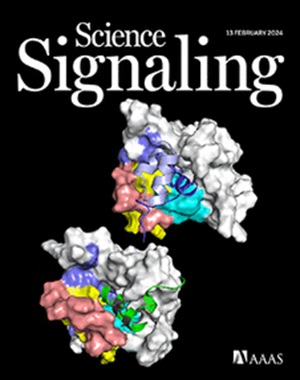Nociceptor-specific signaling of the receptor guanylyl cyclase Npr2 contributes to acute and persistent pain
IF 6.6
1区 生物学
Q1 BIOCHEMISTRY & MOLECULAR BIOLOGY
引用次数: 0
Abstract
Natriuretic peptide receptor 2 (Npr2; also termed guanylyl cyclase B) is a transmembrane guanylyl cyclase that is highly abundant in nociceptors. Here, we investigated the role of production of cyclic GMP (cGMP) by Npr2 in pain processing. Adult mice with a deletion of Npr2 specifically in nociceptive sensory neurons exhibited deficits in noxious heat sensing, which can activate the nonselective cation channels TRPV1 and TRPA1. In parallel, Npr2-deficient mice showed a reduction in TRPV1-mediated nocifensive behavior and Ca2+ influx into sensory neurons. Furthermore, Npr2-deficient mice had considerably reduced hypersensitivity after hindpaw injection of TRPA1 and TRPV1 activators or after hindpaw injection of complete Freund adjuvant, a model of persistent inflammatory pain. These results indicate that Npr2 contributes to the pain sensitization that can lead to chronic pain. Patch-clamp recordings revealed that the endogenous Npr2 ligand, C-type natriuretic peptide (CNP), enhanced the excitability of nociceptive sensory neurons through Npr2. CNP/Npr2 signaling led to the phosphorylation of cysteine-rich LIM-only protein 4 (CRP4), a substrate of cGMP-dependent protein kinase I. Behavioral and electrophysiological analyses using CRP4-deficient mice revealed that CRP4 limited CNP/Npr2-mediated pain sensitization. Our findings reveal a role for CNP/Npr2 signaling in sensory neurons in acute nociceptive and chronic pain and suggest that CRP4 is a downstream target that attenuates pain sensitization.
痛觉感受器特异性信号传导的受体胍基环化酶Npr2有助于急性和持续性疼痛
利钠肽受体2;也称为环化酶B)是一种跨膜环化酶,在痛觉感受器中含量丰富。在这里,我们研究了Npr2在疼痛加工中产生环GMP (cGMP)的作用。在伤害感觉神经元中特异性缺失Npr2的成年小鼠表现出有害热感知的缺陷,这可以激活非选择性阳离子通道TRPV1和TRPA1。同时,npr2缺陷小鼠显示trpv1介导的有害行为和Ca2+流入感觉神经元的减少。此外,npr2缺陷小鼠在后爪注射TRPA1和TRPV1激活剂或后爪注射完全弗氏佐剂(一种持续炎症性疼痛模型)后,过敏反应明显减轻。这些结果表明,Npr2有助于导致慢性疼痛的疼痛敏化。膜片钳记录显示,内源性Npr2配体c型利钠肽(CNP)通过Npr2增强了伤害感觉神经元的兴奋性。CNP/Npr2信号传导导致富含半胱氨酸的LIM-only蛋白4 (CRP4)的磷酸化,CRP4是cmpp依赖性蛋白激酶i的底物。对CRP4缺陷小鼠的行为和电生理分析显示,CRP4限制了CNP/Npr2介导的疼痛致敏。我们的研究结果揭示了CNP/Npr2信号在急性伤害性疼痛和慢性疼痛的感觉神经元中的作用,并表明CRP4是减轻疼痛致敏的下游靶点。
本文章由计算机程序翻译,如有差异,请以英文原文为准。
求助全文
约1分钟内获得全文
求助全文
来源期刊

Science Signaling
BIOCHEMISTRY & MOLECULAR BIOLOGY-CELL BIOLOGY
CiteScore
9.50
自引率
0.00%
发文量
148
审稿时长
3-8 weeks
期刊介绍:
"Science Signaling" is a reputable, peer-reviewed journal dedicated to the exploration of cell communication mechanisms, offering a comprehensive view of the intricate processes that govern cellular regulation. This journal, published weekly online by the American Association for the Advancement of Science (AAAS), is a go-to resource for the latest research in cell signaling and its various facets.
The journal's scope encompasses a broad range of topics, including the study of signaling networks, synthetic biology, systems biology, and the application of these findings in drug discovery. It also delves into the computational and modeling aspects of regulatory pathways, providing insights into how cells communicate and respond to their environment.
In addition to publishing full-length articles that report on groundbreaking research, "Science Signaling" also features reviews that synthesize current knowledge in the field, focus articles that highlight specific areas of interest, and editor-written highlights that draw attention to particularly significant studies. This mix of content ensures that the journal serves as a valuable resource for both researchers and professionals looking to stay abreast of the latest advancements in cell communication science.
 求助内容:
求助内容: 应助结果提醒方式:
应助结果提醒方式:


